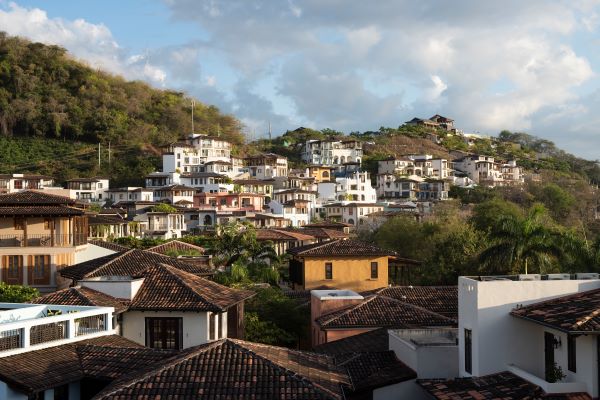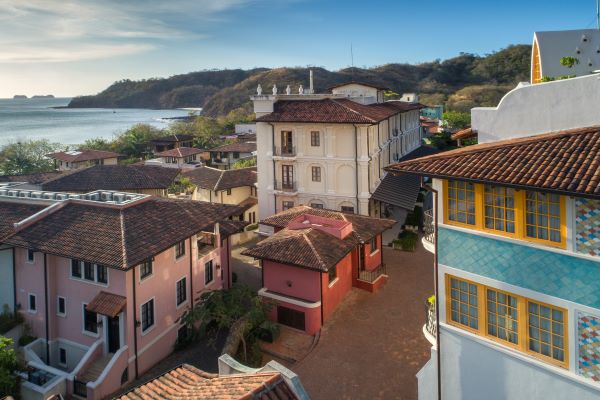






Charles Brewer’s Quest to Save Play — By Banning Cars
Kids running around and playing outside till the streetlights came on.
That was Charles Brewer’s childhood — and dream. To make it happen in modern day America, the entrepreneur developed Glenwood Park in Atlanta, a neighborhood that hewed to the tenets of “New Urbanism.” That mean it had, “town houses, offices, retail, walkable streets, a nice town square, and a park,” Brewer said.
This would be enough, he hoped, to get kids outside to frolic like it’s 1979.
But frolic that way they did not.
The lesson “driven” home:
“I’m still proud of it,” Brewer says of his development. “But it failed to achieve kid freedom.”
How come?
“Because there still were cars.”
That was in 2005. In 2011 Brewer opened a new development. This one was for vacationers and anyone else interested in his halcyon vision of kids out and about on their own. He named it Las Catalinas. It’s a beach town in northwestern Costa Rica:

Presto: Kids outside, running free.
It, too, is walkable, with parks, pedestrian paths, and plazas. But this time?
No cars.
Result?
Says a smiling Brewer, “Kid freedom just happens.”
Especially during the early months of the pandemic, when some vacationing families decided to make Las Catalinas their home for the Covid-days, “It was a magical moment,” Brewer says. “We had an explosion of full-time residents. We went from 30 or 40 to 150 families and lots of kids. We used to have nightly games of man-hunt through the whole town, with a very wide range of ages.”
That kind of fun is now often the stuff of history books, campgrounds, and Spielberg movies. The throughline that connects them all? Way fewer cars. Sometimes even zero. But a couple of other factors also come into play (as it were).
The other ingredients needed for free play.
These include:
- Trust in one’s neighbors.
- The shared belief that kids can do things on their own.
- Knowing no one will call 911 just because they see a kid unsupervised.
- Crucially: On vacation, as at campgrounds, as in the “olden days,” organized activities do not dominate kids’ lives. They have their afternoons and evenings gloriously free.
Play happens automatically when there are other kids around and they’re not in a class or on a device.
Why play matters.
The play drive is incredibly powerful. It was installed by evolution to make sure kids will learn the tough skills they need to function happily in society: How to deal with boredom, spats, risks, fear, and frustration. How to communicate, compromise, and come up with something to do. Play is the most enriching and educational activity around, which is why it is so key to child development. And why Brewer worked so hard, for so long, to bring it back.
Of course, it shouldn’t be that the only kids enjoying old-fashioned free play are the ones on vacation, or in “Stand By Me.” So what can you do in YOUR neighborhood RIGHT NOW to create a little bit of the Las Catalinas’ magic?
How to bring back play wherever you live:
- Get your local government to approve some “play streets” that are officially car-free. (Or do it unofficially, with some traffic cones and saw horses!)
- Organize a block party, so neighbors — including the kids — meet, and kids have a chance to play while the adults are hanging out. Here’s a block party how-to.
- Take turns with your neighbors sitting outside one afternoon or evening a week as the designated “eyes on the street.”
- Create a Playborhood – an area or even just a single yard where kids know play is encouraged, and adults approve of kids going there. Here’s how.
- Start a Let Grow Play Club before or after school at your kids’ school. That’s when a bunch of kids of all different ages get a chance to enjoy “loose parts” free play in a No-Phone-Zone. Our Let Grow Play Club guide for schools is free. Here it is!
At Las Catalinas, Brewer says, “You’d be sitting at a restaurant and this pack of kids just goes blasting through. It is such fun.”
Be like Brewer: Do not let something so precious go extinct. Save play.

Las Catalinas: Cars be gone!



One of the biggest challenges I have encountered is getting people to care about kids… because, for the most part too many just don’t.
This sentence… So well said! Exactly what I’ve been thinking too
Kids run free in Serenbe outside of Atlanta. They have cars there, but it’s so peaceful and there are plenty of speed bumps on the narrow afreets so it seems very safe. They also have an extraordinary amount of forests and open land to play on. But, Serenbe, like Las Catalinas, is not the “real world” except for a lucky few… and some very lucky kids.
To develop communities that can function without cars you pretty much have to start from scratch. When I was a kid the aforementioned cry of “CAR!” worked, but things were different then.
How to create safe havens for children to run free without rebuilding from the ground up is a Herculean challenge. But, it is one to aspire to. One of the biggest challenges I have encountered is getting people to care about kids… because, for the most part too many just don’t.
The beauty of Charles’ message is that his heart is in the right place and he has created something that shows what can be done. Years ago I heard him end a speech with a moving tale of a good friend who was always starting pick-up games of basketball with friends walking by his house. When he “made it” and moved into a grand home he had an indoor court built. Later Charles ran into him and asked how the games were going. The crestfallen man said that nobody ever stopped by anymore. It was too removed from the sight of friends passing by. The story has stuck with me for years.
The more people who strive to find ways for kids to play freely in whatever type of neighborhood or city they live in the better. Charles has created one where he is. Steve Nygren created one in Serenbe. My husband and I welcome the neighborhood children in our yard.
It’s not about creating a car free village or city. It’s about getting more and more grownups to give a damn about the world we are creating for our children and theirs – no matter who “they” may be. This is a long, long, long conversation, as you well know! But, suffice it to say that we are not doing right by our kids by holding them captive and directing their every move. “Child-directed, intrinsically motivated” play in childhood is the only way we are going to end up with happy children – cars or no cars.
Kudos to Charles Brewer for finding a way for it to work in his little slice of heaven. May it inspire others to make it work in theirs.
Traffic Calming and Complete streets leading to small parks would help.
I agree, banning cars is not a sustainable solution. But also where I live, cars speed at 50mph so by the time one kids yells “car!” another one could have been run over. In societies where people are better educated, cars speeding in residential areas are not an issue. Maybe start there?
How about just doing what kids used to do when they were playing in the street in the days of real freedom–the first kid to see a car coming yells “car!”, and everybody moves out of the way until it has passed. Simple. Works.
Banning cars from streets always causes problems. Traffic backups are exacerbated. Cars are re-routed through other neighborhoods, increasing traffic there. People can’t get where they need to go. Businesses are harmed. It never works.
As long as adults are planning kids’ play, appointing a grownup to sit on the porch and watch, designating an official play yard, etc., etc., kids won’t truly be free. If it was your idea, and you’re watching, it’s not free play.
Now attack me, as I go about my day not worrying about it.